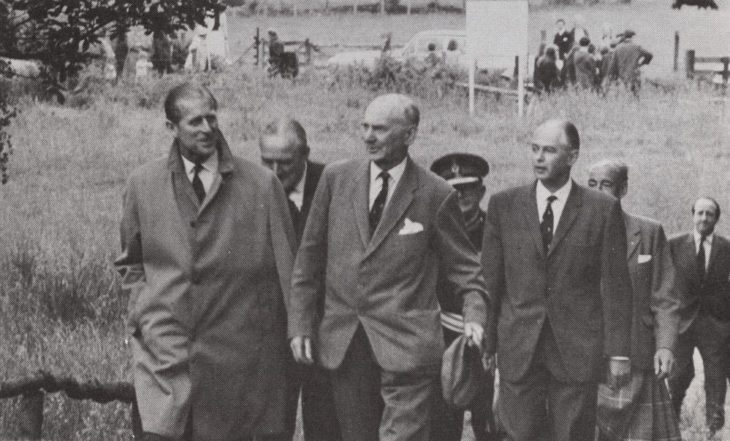Formed in April 1964, the Scottish Wildlife Trust is a membership-based charity with the objective to “advance the conservation of Scotland’s biodiversity for the benefit of present and future generations.”
For 60 years, the Trust has grown significantly in terms of supporter-base, influence and numbers of reserves, and is today Scotland’s leading nature conservation charity.
Here are some of the Trust’s historical highlights:
1960s
1964 – Scottish Wildlife Trust is formed in Edinburgh by a group led by Sir Charles Connell.
1965 – The Trust recruits its 400th member as well as its first member of staff, Bernard Gilchrist, and launches the Scottish Wildlife journal.
1967 – The Tweed Valley ‘Branch’ becomes the first Local Group.
1968 – With over 1,700 members, the Trust’s income exceeds £5,000 for the first time. The Falls of Clyde becomes a Trust reserve.
1969 – The Trust purchases Loch of the Lowes in Dunkeld.
1970s
1973 – Prince Philip, Duke of Edinburgh, visits Loch of the Lowes and Duddingston Loch. Membership exceeds 5,000 for the first time.
1974 – The Trust’s focus broadened from wildlife reserves to the wider countryside.
1976 – The Trust purchased Montrose Basin in March, and awarded its first honorary memberships to Dr George Waterston and Duncan Anderson.
1977 – The Rt Hon Sir Angus Ogilvy became the charity’s first Patron.
1978 – The Trust is awarded a grant of £8,000 from Nature Conservation Council for environmental education.
1979 – Junior membership for ages 9-15 became the ‘Watch Club’. Tailend Moss in the Lothians became the Trust’s 50th reserve.
1980s
1981 – The Trust’s headquarters moved to Johnston Terrace, Edinburgh. The Wildlife and Countryside Act is passed after widespread campaigning.
1983 – The Trust highlighted the dangers of acid rain and called for action to combat it.
1984 – Dr David Bellamy opened the Falls of Clyde Visitor Centre.
1990s
1990 – The Duke of Rothesay became the Trust’s new Patron. At this time, the Trust had 84 reserves, 50 full-time staff, 150 trainees and 8,800 members. The Trust’s headquarters moved to Cramond House.
1991 – Organised the first National Bog Day. By 1996, this evolved into International Bog Day which remains an established annual event every July having laterally been adopted by the IUCN UK Peatland Programme.
1992 – Jupiter Urban Wildlife Centre in Grangemouth is opened by Magnus Magnusson.
1995 – Montrose Basin Visitor Centre officially opened to the public. The Trust completed the 3-year Scottish Raised Bog Conservation Project, during which 143 raised bogs were surveyed and the Bog Management Handbook was written and published.
1996 – The Trust’s launched its first biodiversity campaign, the “Web of Life”.
1997 – European funding is secured for peat bog protection and restoration. Membership was 13,800.
2000s
2001 – The Trust received £3.6 million of Heritage Lottery funding to improve reserves and visitor centres.
2002 – The Trust now managed 120 reserves in Scotland.
2004 – This year saw the largest rise in membership to date, with 25,000 people now supporting the charity.
2006 – The Trust launched it’s new 25-year vision.
2008 – The Trust was involved with reintroducing beavers to Scotland for the first time in over 400 years as part of the Scottish Beaver Trial at Knapdale.
2009 – The Marine Act is passed by Scottish Government after months of campaining.
2010s
2011 – The Trust exceeded 30,000 members for the first time, and achieved a turnover of £5 million. Headquarters moved to Harbourside House in Leith.
2013 – Trust membership exceeded 35,000. The Trust organised the first World Forum on Natural Capital, attracting 500 delegates from 35 countries.
2015 – The Trust organised the second World Forum on Natural Capital, attended by over 600 delegates from 45 countries. 50 for the Future is published, highlighting 50 things that the Trust would like to see happen over the next 50 years in Scotland.
2016 – The Trust launched Scotland’s first ever snorkel trail in the north west Highlands and set out its vision for the Scottish uplands. Heritage Lottery funding worth £2.9 million is secured for the Coigach-Assynt Living Landscape Partnership. Membership exceeded 40,000 for the first time. The Scottish Government announced that beavers were to remain in Scotland following the successful Scottish Beaver Trial.
2017 – The Trust won the Youth & Education category of the Nature of Scotland Awards for Cumbernauld Living Landscape‘s Engaging Communities project, and the Nature Tourism category for the North West Highlands Snorkel Trail.
2018 – Launched the fourth in our Policy Future series focusing on Living Cities.
2019 – The Scottish Government announced that beavers were to become a legally protected species. The Trust launched the pioneering Irvine to Girvan Nectar Network.
2020s
2020 – Saved Coul Links from a golf course development following several years of campaigning as part of a coalition of NGOs.
2021 – Developed Scotland’s first Nature Network in collaboration with the City of Edinburgh Council.
2022 – Launched the Pioneers Programme as part of the National Lottery-funded Nextdoor Nature project.
2023 – Launched the Oceans of Value film as part of a project of the same name which adopted the Community Voice Method to capture the views of people on Orkney on how they would like to see the marine environment managed in the future.

